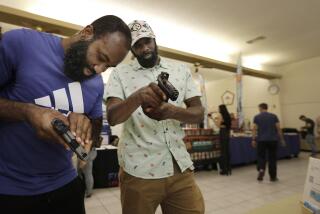Judge ‘Inclined’ to Hearing on Selective Prosecution of Minorities
A Los Angeles federal judge said Monday that a defense lawyer had “made a prima facie case” that the U.S. attorney’s office selectively prosecuted her Latino client under a law that imposes harsh penalties for dealing drugs near a schoolyard, playground or video arcade.
U.S. District Judge Mariana R. Pfaelzer directed Assistant U.S. Atty. Alan Dahle to submit a written response within two weeks to allegations lodged by North Hollywood defense lawyer Mary F. Gibbons.
But “right now, I’d be inclined to say” there should be a full evidentiary hearing on Gibbons’ allegation that the government selectively prosecuted minorities under the 1986 federal schoolyard law, Pfaelzer said.
U.S. District Judge Terry J. Hatter Jr. already has scheduled a June 10 evidentiary hearing on contentions by defense lawyers that four other minority clients were selectively prosecuted by federal prosecutors. Officials of the U.S. attorney’s office and Los Angeles Police Department, who were involved in implementing the program, will be called as witnesses.
Hatter ruled March 18 that those defendants had made a prima facie case of discrimination, meaning that their argument could withstand an initial challenge by the other side.
To prove selective prosecution, a defendant must show that other individuals in similar circumstances had not been prosecuted for the same conduct and that the government’s selection of a defendant was based on impermissible grounds such as race or religion.
Gibbons termed what happened to her client, Jose Bellido, “a dramatic injustice.” Bellido, 34, was arrested in MacArthur Park in June, 1989, and charged with selling 4.7 grams of rock cocaine to an undercover police officer as part of a massive sweep. He has been held without bail since then pending trial.
Gibbons cited statistics showing that 89 of 93 people prosecuted in Los Angeles federal court under the schoolyard law have been black or Latino.
Meanwhile, she said, the U.S. attorney’s office has not prosecuted Anglo defendants who committed similar crimes. Specifically, she cited the cases of seven Anglos arrested during the same sweep whose cases were rejected for federal prosecution by Special Assistant U.S. Atty. Susan Bryant Deason, who ran the program to curb schoolyard drug sales. Their cases were referred to state court.
During a one-hour hearing Monday, Pfaelzer agreed that the question of where a defendant was prosecuted is no minor matter. Under the terms of laws in effect at the time of the sweep, a defendant prosecuted in federal court could get a 20-year sentence for the same crime for which a defendant in state court could get a six-month term.
Dahle argued that there were good reasons for rejecting the seven cases for federal prosecution. There was a problematic search in one instance, he said, insufficient drugs to warrant federal prosecution in another and no evidence that a third person arrested--a man seeking to buy drugs--had committed a crime.
Gibbons disputed those explanations, noting that when Bryant-Deason rejected the first case, for instance, she did not have the police report that indicated there were problems with the search.
Gibbons and Dahle also disagreed over the significance of a January, 1988, letter sent by then-U.S. Atty. Robert C. Bonner to Chief U.S. Magistrate Ralph J. Geffen. Reporting that the U.S. attorney’s office was about to launch a major initiative under the schoolyard law, the letter expressed hope that defendants arrested would be detained without bail pending trial so that they would not commit more crimes.
Gibbons said the government was improperly trying to influence judicial bail decisions. But prosecutor Dahle said the letter was simply an exercise of common courtesy by Bonner to advise the magistrates, who handle the initial phases of most cases, that their workload would be increasing.
Pfaelzer seemed troubled by the letter and asked Dahle to submit a written response on “the detention issue.”
Gibbons and Dahle also disagreed over the significance of racial references in handwritten notes made by Bryant-Deason while considering cases referred by local police. Among the terms were “Mex,” “Jamaicans,” “Black man,” and “cau,” short for Caucasian. Dahle said his colleague was just noting comments made to her by police officers, but Gibbons said that the notes showed racial considerations in deciding who would be prosecuted.
More to Read
Sign up for Essential California
The most important California stories and recommendations in your inbox every morning.
You may occasionally receive promotional content from the Los Angeles Times.










